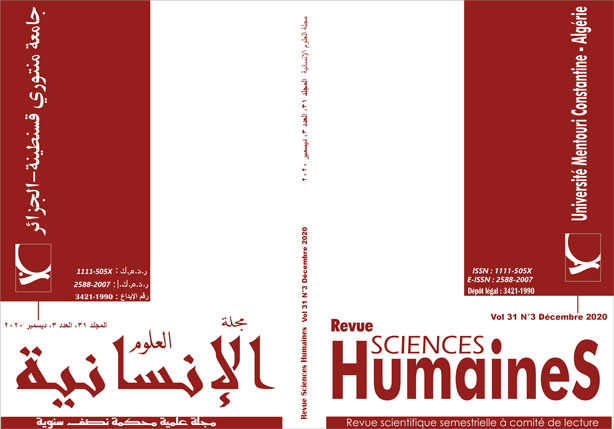Approaching Culture through Humour in the EFL Classroom
at the Department of Letters and English, University of Frères Mentouri Constantine1
Keywords:
language learning, culture, humour, UniversityAbstract
Teaching a language as a system outweighs its cultural underpinnings which enfold a large amount of what is said. This calls for a reconsideration of the way of teaching so as to give culture its weight. Over seriousness in classrooms tends to fan the flame of tension and anxiety among students; consequently, classrooms should be designed with an appealing atmosphere that encourages the learning process and impedes boredom. To this end, humour makes a convenient teaching method which both eliminates boredom, and stimulates culture learning. Thus, the aim of this paper is to get an insight into students' willingness to study culture through the humorous tunnel. A descriptive study relying on a questionnaire, as a research tool, is used to see the validity of humour in the classroom. The questionnaire is addressed to a sample of 46 second year students extracted from a population of about 250 students at the Department of Letters and English, University of Frères Mentouri, Constantine 1. Findings reveal that humour is worth incorporation in the EFL classroom because it both generates a cosy, stress-free atmosphere and helps to learn about the target culture.
Downloads
References
Aboudan, R. (2009). Laugh and Learn: Humour and Learning a second Language. International Journal of Arts and Sciences, 3 (3),90-99. http:// www. Researchgate. net
Abraham, R., Hande, V., Sharma, M., Wohlrath, S., Keet, C.,& Ravi, S.(2014). Use of Humour in Classroom Teaching: Students' Perspectives. Thrita Journal, 3 (2). doi: 10.5812/ thrita.10517. thritajournal. portal.tools
Alred, G., Byram, M., &Fleming, M.(Eds.).(2003). Intercultural Experience and Education. Britain, UK: Multilingual Ltd Matters.
Boone, H., & Boone, D. (2012). Analysing Likert Data. Journal of Extension. 50 (2). www. joe. org
Byram, M. (1989). Cultural Studies in Foreign Language Education. Clevedon, Avon: Multilingual Matters.
Byram, M. (1997). Teaching and Assessing Intercultural Communicative Competence. Clevedon: Multilingual Matters Ltd.
Byram, M., & Fleming, M., (1998). Language Learning in Intercultural Perspective: Approaches through Drama and Ethnography. UK: Cambridge University Press.
Coolican, H., Research Methods and Statistics in Psychology. Hodder &Stoughton, Hodder Headline Group.
Corbett, J., (2003). An intercultural Approach to English Language Teaching. Clevedon, Multilingual Matters Ltd.
Hanoune, S., (2012). Humour in English Foreign Language Teaching. EL-Tawassol: Langues, Culture et Littérature. 31: 79-88. dpubma. univ-annaba.dz
Harrison, B.,(Ed). (1990). Culture and the Language Classroom. The British Council: Modern English Publication.
Hinkel, E., (1999). Culture in Second Language Teaching and Learning. New York, NY: Cambridge University Press.
Hofstede, G.J., Pedersen, P., Hofstede, G. (2002). Exploring Culture. London, UK: Intercultural Press.
Kramsch, C., (1993). Content and Culture in Language Teaching. New York, NY: Oxford University Press.
Ladousse, G.P. (1987). Role Play. New York, NY: Oxford University Press.
Martin, R., (2007). The Psychology of Humour: an Interactive Approach. Burlington, MA: Academic Press.
Medgyes, P. (2002). Laughing Matters: Humour in the Language Classroom. New York, NY: Cambridge University Press.
Merriam, D. (2014). Merriam Webster Dictionary online. Retrieved from http: //www. merriam-webster. com/dictionary/humour
Miller, S. (1984). Experimental Design and Statistics. London: Routledge.
Pallant, J. (2005). SPSS Survival Manual: a Step by Step Guide to Data Analysis Using SPSS. Australia: Allen & Unwin.
Plester, B. (2016). The Complexity of Workplace Humour: Laughter, Jokes and the Dark Side of Humour. London: Springer International Publishing.
Raskin, V. (1985). Semantic Mechanisms of Humour. Dordrecht, Holland: D. Reidel Publishing Company.
Richards, J. & Rodgers, Th. (1986). Approaches and Methods in Language Teaching: A Desciption and Analysis. Cambridge: Cambridge University Press.
Shade, A. (1996).License to laugh: Humour in the Classroom. USA: Teacher Ideas Press.
Singh, Y. (2006). Fundamental of Research Methodology and Statistics. New Delhi, India: New Age International Publishers.
Sinscalco, M., & Auriat, N. (2005). Quantitative Research Methods in Educational Planning. UNESCO International Institute for Educational Planning. http://www. Unesco.org/iiep
Simpson, P. (2003). On the Discourse of Satire. Amsterdam, Netherlands: John Benjamins B.V.
Stryker, S.B., & Leaver, B.L. (Eds). (1997). Content-based Instruction in Foreign Language Education: Models and Methods. Washington: Georgetown University Press.
Tomlin, B., & Stempleski, S.(1993). Cultural Awareness. New York, NY: Oxford University Press.
Wagner, P. (2007). Let's Laugh: Discovering How Laughter Will Make You Healthy. USA: Destiny Image Publishers, In
Downloads
Published
How to Cite
Issue
Section
License

This work is licensed under a Creative Commons Attribution-NonCommercial-ShareAlike 4.0 International License.
















